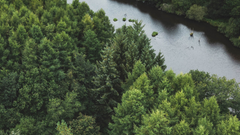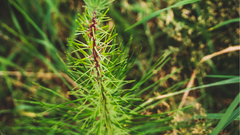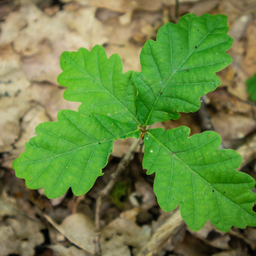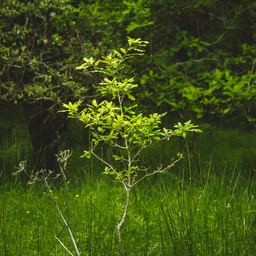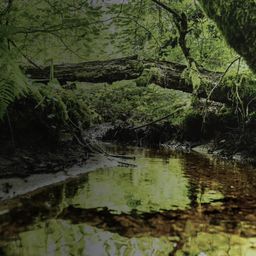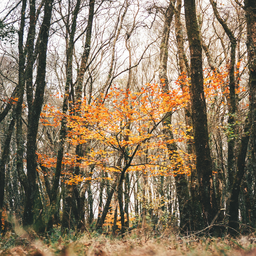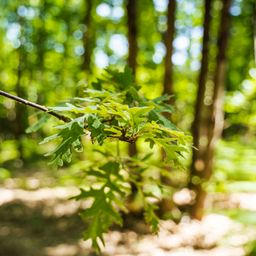May 27, 2024
Tree Talk: Exploring the Communication of Forests
We are now becoming aware that trees are more complex than we thought, and that they live in constant interference with their environment.
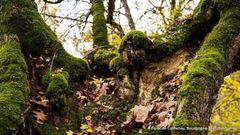
Over the last few decades, science has made some astonishing discoveries about trees. For a very long time in the West, trees were regarded either as raw material for wood, or at best as decorative objects, but we are now realising that they are more complex than we thought, and that they live in constant interference with their environment. What if trees could communicate with each other?
A surprising underground communication network
Peter Wohlleben wasn't the first to discover it, but he is credited with bringing public attention to the underground network through which trees exchange information and much more. In his bestseller, The Secret Life of Trees, German forester Peter Wohlleben revealed that a gigantic network of microscopic fungi enables trees to exchange information. He calls this network the Internet of the forest, and with good reason: the mycorrhizae that can even be seen with the naked eye under the dead leaves of trees in a beech forest, for example, are so many little ‘cables’ by which the trees are linked to each other.
Discover the life cycle of a tree
Mycorrhiza, from the Greek myco, ‘fungus’, and rhiza, ‘root’, is a term introduced in 1885 by the botanist Albert Bernhard Frank. It defines the symbiotic relationship that exists between tree roots and the long underground threads woven by mycelia, which, if you map them underground, resemble our worldwide web. That's why biologists call it the wood-wide web. In 1997, Canadian researcher Suzanne Simard was the first to demonstrate this mycorrhizal carbon transfer network between trees in natural conditions.
So, far from getting in each other's way, fungi and trees live in harmony and have developed a form of mutual aid that leads us to believe that one would not live without the other, and vice versa, or with the greatest difficulty. The two exchange organic matter and minerals, with the fungi drinking the water captured and stored by the tree roots.
For example, scientists have shown that 30 to 40% of the minerals captured by the mycelial network are returned to the roots. In comparison, the roots provide 20 to 40% of the carbohydrates photosynthesised by the fungi. These relationships are so essential that so-called pioneer plants, which colonise virgin areas and therefore lack mycorrhizae, compensate for the absence of the fungal helper by developing root structures that mimic mycelial filaments.
But mycorrhizae have yet another use for trees.
When mushrooms act as telephones for trees
The plant world is far more complex and intelligent than we might think. While trees' intelligence still raises a few minor criticisms, their capacity to adapt is well established, as is their memory, not to mention the defence strategies they can implement to protect each other. It is through the root network that trees of the same species communicate with each other within a forest, but not only that. As a television report broadcast on Envoyé spécial clearly shows, collective strategy is the order of the day between congeners.
When a tree, say a beech, is attacked by caterpillars, parasites or simply a deer that has come to graze on its leaves or buds, it immediately warns its congeners of the danger that has arrived. Like birds, which utter easily recognisable cries when a predator enters the vicinity, trees warn each other. They are only slower, but the information passes from the branches to the roots, via the trunk, and from the roots to those of the other trees to which they are connected. The alarm signal works like an electrical impulse and is transmitted at one centimetre per minute. Suppose it is a predator that has come to attack the leaves. In that case, the other specimens in the same family will set up an immediate defence strategy by producing antibodies in the form of bitter tannin, which makes the leaves inedible. The deer or caterpillar has to move on.
Scientists have only measured communication between trees when they are under stress. Peter Wohlleben makes no secret that he would like to determine whether trees send each other messages when conditions are favourable or to communicate their joy or well-being, which is not impossible.
Another form of communication that he noted, which is the starting point of his book and which has been indicated in other situations, is the mutual assistance of trees via the root system when one is ill, for example. This is how a dead stump can be kept alive by a vigorous neighbouring tree. The latter shares the nutrients it has transformed through photosynthesis to wake up the sleeping tree and support it until it is strong enough to feed itself. Similarly, young plants growing in the shade of larger plants often do not get enough light to photosynthesise their nutrients. In these cases, it is the older plants that feed them via the hyphae of the fungi.
It also seems that old trees do not let themselves die until their progeny are assured, and even before dying, some of them pass on the nutrients they have stored to their neighbours.
Mother trees feed their offspring, and only their offspring - those from their seeds - until they can replace them. Once again, this is done through the roots. The beech tree is thus able to recognise, by its roots, the tree that carries its DNA, just as it can distinguish between a tree of the same family and a stranger.
But two trees of different species can also exchange information and food. For example, the Douglas fir and the white Birch live in symbiosis. When the paper birch is leafless in autumn and winter, carbon and nitrogen are supplied by the Douglas fir, while the process is reversed when the birch has grown and grown abundant foliage in summer.
Trees communicate through the air
However, the root system is not the only way trees communicate with each other. Like us, they have developed several senses. It is not just touch but taste, smell, and even sight. Look at two large beech or oak trees growing side by side for decades. Neither bothers the other and each, out of modesty or respect, holds back the growth of its largest branches so that they don't worry about the other while it pushes them away from the side that doesn't bother it. In the same way, their crowns will not touch, and unless they are competing for light, which generally happens when they are not the same age, both will respect their neighbour's living space.
Phytoncides are another way for trees to communicate. The Russian biologist Boris Petrovich Tokin coined this term to describe all the volatile antimicrobial organic compounds emitted into the air by trees and herbaceous plants. These are molecules biosynthesised by plants to defend themselves against pathogenic micro-organisms. They are present in the air surrounding the plants that emit them, and although invisible, humans and animals inhale them through the skin and the respiratory tract. This is one of the main subjects of the famous sylvotherapy, which the Japanese call shinrin-yoku, which leads them to say that a walk in the forest is an excellent way to get rid of pathogens.
This elaborate chemical language enables trees to exchange information, if not beneficial elements constantly. So trees are in constant contact with each other, warning each other of dangers, supporting each other in difficult times and redistributing the fruits of their labours through the air and underground. Yes, trees communicate, and we are far from finished discovering everything they have to say and offer each other.
Keep on reading!
- Overcoming Steep Slopes and Sandy Terrain in Ajoux
- Transforming depleted farmland into new mixed-species forest
- What is a tree?


